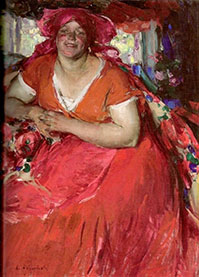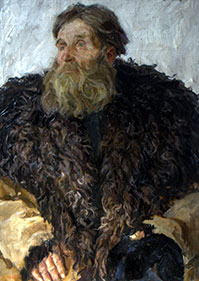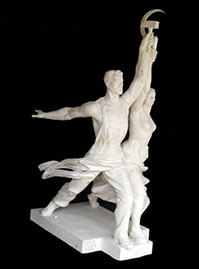
Abram Arkhipov, ‘Young peasant woman,’ 121 x 93cm

Arkadi Plastov, ‘Portrait of a man called Meshova,’ 86 x 65cm

Vera Mukhina, ‘Worker and Kolkoz woman,’ 163 x 112 x 116cm
Russian Art – The 20th century – An introduction
Russian art of the 20th century is a many-layered topic and consists of a variety of overlapping and sometimes competing groups and movements. Below we list and discuss some of the better-known movements of the Russian soviet era.
Jack of Diamonds
A group of artists formed this movement in 1909 in Moscow and it is considered the first wave of the Russian Avant-Garde. Pre-revolutionary artists had no restriction on travel and most of them spent formative years in Paris where they fell under the influence of the French Post Impressionists and Cubism. They took their name from their initial exhibition in 1909 and developed a colourful style that was a firm break from the 19th century Russian tradition of Repin, Shishkin and Levitan. Key figures included Kazimir Malevich, Pyotr Konchalovsky, Robert Falk, Mikhail Larionov, and Natalia Goncharova. Major works by these artists rarely appear on the art market and when they do, can fetch many millions of dollars.
Russian Avant-Garde
A general term that is used to describe Russian modern art (including the aforementioned Jack of Diamonds Group) period that existed from the beginning of the 20th century up until the rise of the state sponsored Socialist Realism style that was established by 1930. Many of the former Avant-garde artists such as Kazimir Malevich from around 1920 had to change their style to conform with Socialist Realism in order to avoid being seen as subversive and sent to the Gulag.
Constructivism
The Avant-Garde incorporated painting, sculpture, photography and architecture. In line with Bolshevik thinking after the revolution of 1918, Constructivists rejected the idea of autonomous art in favour of art with a social purpose. This new art, and in particular, the architecture, borrowed the concentric forms of Cubism and Futurism. Vladimir Tatlin was a key figure in this movement alongside Alexander Rodchenko, Vavara Stepanova and Gustav Klutsis.
Socialist Realism
The Bolsheviks realised they could use art for propaganda purposes and they controlled artistic production as carefully as they controlled everything else in the new Soviet State. They decreed that art should be realistic (i.e. representational) in style and socialist in content. This type of art, which dominated art in the Soviet Union from 1930 – 1970, was much derided in the West as mere propaganda. The movement rejected the earlier Avant-Garde as decadent and in 1932 laid down a template that art should glorify the workers and the state and return to the realistic tradition of painting that had dominated Russian art in the 19th century. The first generation of this art contained artists that have now become sought after and valuable such as Aleksandr Deinika, Yuri Pimenov and Aleksandr Samokhvalov. The following generation including Arkadi Plastov and Vladimir Stozharov are also coming to be appreciated as major figures.
The Severe Style
In the 1960’s after the death of Stalin in 1953 and a relaxing the Socialist Realist dogma during the so-called Khrushchev ‘Thaw’ a group of the more adventurous artists such as Pavel Nikonov and Nicolai Andronov formed what is called the ‘Severe Style.’ They reworked the accepted Socialist realist subjects to show more of the severity of post war life in Russia. A key work of this period such as Andronov’s ‘Raftsman’ of 1961 (Tretyakov gallery) uses a Cezannist clarity derived from Konchalovsky and other ‘Jack of Diamonds’ painters. The composition is sparse and all non-essential detail is eliminated. Aleksandr Deinika and Kuzma Petrov-Vodkin also influenced these artists. Important artists of this school include Geli Korzhev, Victor Ivanovich Ivanov, Valentin Sidorov, Petr. Ossovski and Viktor Popkov. Interest in this school of art is just starting to develop.
Non Conformism
Known as ‘unofficial art’ this term refers to art made in the Soviet Union between 1950 and 1980 that neither fits into the Socialist Realism or the Severe schools of art. These artists had to operate secretly and often had little contact with each other which means the movement lack cohesion. It encompasses both Sots art and Moscow conceptualism and included artists such as Oleg Tselkov, Ilya Kabakov and Oscar Rabin. Interest started to develop in these artists around 2005 but seems to have subsided as many of these artist are interesting because of their political stance as opposed to the quality if their work. Sots art is sometimes referred to as Soviet Pop Art and is a term that was coined by the non conformists Komar and Melanid to describe work that undermined Soviet iconography. Other artists in this group include Eric Bulatov and Leonid Solov.
Sculpture
Soviet sculptors include some talented individuals whose work can be seen by spending an afternoon in the Tretyakov gallery. In addition to the monumental public monuments they were required to make for the state these sculptors made a fine body of more personal works using stone, plaster, bronze and wood. Outstanding sculptors of the Soviet period include Aleksandr Matveev, Vera Mukhina, Sergei Konenkov, Joseph Chaikov, Ivan Shadr, Evgeny Vuchetich, Matvei Manizer, Sara Lebedeva and Ekaterina Belashova. For many years such sculpture was not on public view in the Tretyakov but the Tretyakov has recently started displaying such sculptures again and held its first dedicated Soviet Sculpture exhibition for many years in May 2012.
29,181 total views, 1 views today


 Lindsay Russian Art - Agents and Dealers in Russian Art
Lindsay Russian Art - Agents and Dealers in Russian Art